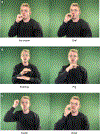Sign Language: How the Brain Represents Phonology without Sound
- PMID: 33202232
- PMCID: PMC8527985
- DOI: 10.1016/j.cub.2020.09.017
Sign Language: How the Brain Represents Phonology without Sound
Abstract
A rare case of a deaf signer undergoing awake craniotomy has revealed that sensorimotor cortex is functionally organized for signing. Electrocorticography recordings indicated neural tuning to linguistically-relevant handshapes and body locations and distinct neural activity for linguistic versus transitional movements.
Copyright © 2020 Elsevier Inc. All rights reserved.
Figures

Comment on
-
Cortical Encoding of Manual Articulatory and Linguistic Features in American Sign Language.Curr Biol. 2020 Nov 16;30(22):4342-4351.e3. doi: 10.1016/j.cub.2020.08.048. Epub 2020 Sep 3. Curr Biol. 2020. PMID: 32888480 Free PMC article.
Similar articles
-
Cortical Encoding of Manual Articulatory and Linguistic Features in American Sign Language.Curr Biol. 2020 Nov 16;30(22):4342-4351.e3. doi: 10.1016/j.cub.2020.08.048. Epub 2020 Sep 3. Curr Biol. 2020. PMID: 32888480 Free PMC article.
-
Successful Insular Glioma Removal in a Deaf Signer Patient During an Awake Craniotomy Procedure.World Neurosurg. 2017 Feb;98:883.e1-883.e5. doi: 10.1016/j.wneu.2016.08.098. Epub 2016 Sep 1. World Neurosurg. 2017. PMID: 27593723
-
How the hand has shaped sign languages.Sci Rep. 2022 Jul 13;12(1):11980. doi: 10.1038/s41598-022-15699-1. Sci Rep. 2022. PMID: 35831441 Free PMC article.
-
Statistical evidence that a child can create a combinatorial linguistic system without external linguistic input: Implications for language evolution.Neurosci Biobehav Rev. 2017 Oct;81(Pt B):150-157. doi: 10.1016/j.neubiorev.2016.12.016. Epub 2016 Dec 29. Neurosci Biobehav Rev. 2017. PMID: 28041786 Free PMC article. Review.
-
Syllable as a unit of information transfer in linguistic communication: The entropy syllable parsing model.Wiley Interdiscip Rev Cogn Sci. 2020 Jan;11(1):e1518. doi: 10.1002/wcs.1518. Epub 2019 Sep 10. Wiley Interdiscip Rev Cogn Sci. 2020. PMID: 31505710 Review.
Cited by
-
Awake surgery for a deaf patient using sign language: A case report.Surg Neurol Int. 2024 May 24;15:167. doi: 10.25259/SNI_52_2024. eCollection 2024. Surg Neurol Int. 2024. PMID: 38840599 Free PMC article.
References
-
- Brentari D (2019). Sign Language Phonology (Cambridge University Press; ).
-
- Thompson R, Emmorey K, and Gollan TH (2005). “Tip of the fingers” experiences by deaf signers: insights into the organization of a sign-based lexicon. Psych. Sci 16, 856–860. - PubMed
-
- Klima E, and Bellugi U (1979). The Signs of Language (Harvard University Press; ).
Publication types
MeSH terms
Grants and funding
LinkOut - more resources
Full Text Sources

